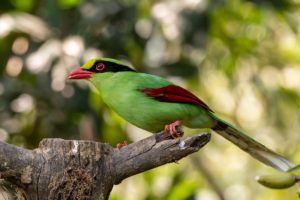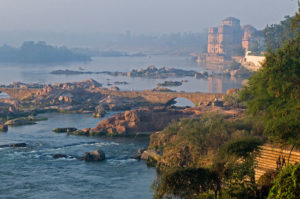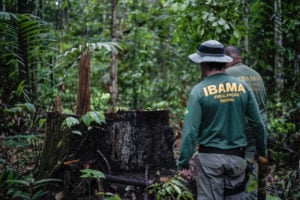Researchers in the Himalayas are increasingly turning to environmental DNA, or eDNA – genetic material left behind by organisms in air, soil and water – to strengthen efforts to protect biodiversity and livelihoods.
eDNA-based surveys detect the presence of plants, animals and microorganisms from organic matter such as skin, mucus, hair and feces in samples as small as a cup of river water.
Scientists in India, Nepal and Bhutan have been adding these biological castoffs to their survey toolkit – which includes camera traps and trawl nets – to find out what is already present in sites of intense interest for conservation. Determining the biodiversity of an area at a particular point in time is the first step to designing any effective conservation strategy and environmental impact assessments (EIA) for developmental projects.
eDNA can be a game changer for studying Himalayan ecosystemsNakul Chettri, senior biodiversity specialist at the Kathmandu-based International Centre for Integrated Mountain Development (ICIMOD)
eDNA’s use has ballooned over recent years. In 2022, it was utilised in a large-scale campaign documenting the biodiversity of Mount Everest. Between September 2022 and April 2023, it was used in a Unesco initiative in which citizen scientists collected eDNA across 22 marine World Heritage Sites. It was also used to measure local differences in biodiversity across ports in Southern California.
The technology overcomes key limitations of conventional survey techniques such as trawling –where a net is dragged along in a body of water – which can be disruptive to animal habitats and often results in lower diversity of species being identified.
“eDNA can be a game changer for studying Himalayan ecosystems, whose rugged and largely inaccessible terrains make it difficult to cover the sampling range physically, and therefore [leaves it] poorly explored,” says Nakul Chettri, senior biodiversity specialist at the Kathmandu-based International Centre for Integrated Mountain Development (ICIMOD). These underexplored regions include biodiversity-rich areas outside of protected areas, such as tea plantations and agricultural fields on the fringe of Kaziranga National Park in India’s northeastern Assam state in the eastern Himalayas.
Applying eDNA technology in such fringe areas is crucial for uncovering biological unknowns, monitoring biodiversity where there is typically less attention paid, and comprehending the intricate relationships shaping ecosystems in the Himalayas, Chettri notes.
However, experts say the success of eDNA surveys in the region will be contingent on establishing reference DNA libraries of genetic information from identified species to compare collected eDNA, alongside building capacity to conduct eDNA analyses and standardisation of sampling protocols.
Informing mitigative practices for endangered species
In Nepal, eDNA-based studies have helped map the comparative impacts of hydropower projects on fish diversity in the dam-riddled Trishuli, as well as Karnali – Nepal’s last remaining dam-free river.
Karnali contains more diverse and abundant fish species than Trishuli – a “drastic difference” in diversity that surprised the team at the Centre for Molecular Dynamics Nepal, notes the founder of the centre, genetic scientist Dibesh Karmacharya.
Through eDNA, the team discovered the presence of invasive species, such as rainbow trout, even in reasonably pristine rivers like Karnali, and conducted the first eDNA studies of the area to map the total fish biodiversity, through which they discovered the presence of invasive species.
They analysed eDNA in different parts of four rivers – Karnali, Trishuli, Dodhkoshi and Mahakali – which showed presence of endangered species including golden mahseer in different stretches of some of these rivers, revealing the species’ migratory path. With this knowledge, the team learned that the migratory path of these endangered species could be disrupted by hydropower dams.
The group has painstakingly profiled aquatic biodiversity in Trishuli, Karnali, Gandaki, and Mahakali rivers using eDNA, developing extensive datasets to monitor the long-term health of the river systems – building the country’s first fish DNA reference database in the process. “Before we started working, the fish species database from Nepal was almost non-existent,” says Karmacharya.
Efforts to build the reference DNA contributed to embedding eDNA in the Trishuli Assessment Tool, a standardised method for sampling freshwater aquatic biodiversity for use in planning hydropower projects, with eDNA providing an image of species that live in the environment in more detail than other methods. Next, the team will be profiling the eDNA of important Nepal glaciers for the first time.
Policymakers and ecosystem managers looking to restore the Deepor Beel, a wetland of international importance under the Ramsar Convention in the Indian state of Assam, have been relying on eDNA studies to glean a snapshot of its biological diversity, which is rapidly changing due to the effects of climate change and rising anthropogenic pressures including pollution. Understanding the impacts of anthropogenic changes on fish in Deepor Beel has been central to ensuring livelihood security for the 150 families of mostly fishers the wetland supports.
The eDNA dataset, which covers fish species and microorganisms in the wetland, is the first collected for any Ramsar-listed wetland in northeastern India. “eDNA was the best option because we can’t afford to lose time in taxonomically identifying fish species [as new species identification requires specialist knowledge],” says Punyasloke Bhadury, a scientist at the Indian Institute of Science Education and Research Kolkata.
“We need to do more surveys to refine the dataset and truly capture all the species in the wetland [before even more of them go extinct],” adds Rajkumari Nikita, a PhD student at the institute’s Centre for Climate and Environmental Studies, who conducted eDNA surveys at Deepor Beel.
Scaling up eDNA surveys
eDNA is well-suited to the Himalayan ecosystems, especially transboundary rivers and remote terrains, to understand ecosystem health by using species populations as an indicator, notes Chettri.
Biologist Pushpinder Singh Jamwal and researchers at the University of Milano-Bicocca recently tested the results of eDNA surveys that identified the presence of Eurasian otters (Lutra lutra) in the Indus river drainage of Ladakh in the Trans-Himalayas against a traditional field survey that uses direct otter sightings. In their study, otter DNA was found at 73% of the sites, whereas the species was seen at just 53%.
“Beyond detection, the study provides new insights into the ecology of the Eurasian otter in the Indian Trans-Himalayas, [which is] necessary for framing comprehensive conservation strategies that go beyond mere presence/absence assessments,” Jamwal notes, such as developing early warning systems for changes in otter populations or habitat quality.
In 2022, a pilot eDNA survey in the Mangdechhu river basin in south-central Bhutan commissioned by the country’s Department of Forests and Park Services uncovered the presence of endangered and vulnerable species including the white-bellied heron, tiger and gaur. The next step is incorporating eDNA into species conservation in Bhutan, says Kezang Yangden, Conservation Director at WWF-Bhutan, which assisted in the survey.
However, the lack of capacity to conduct eDNA analyses in Bhutan – in terms of infrastructure, equipment, and expertise – is a major challenge in advancing the technology’s application in the country, she notes.
Extreme weather conditions in the Himalayas can also disrupt the research environment, impacting the effectiveness of sampling and the quality of collected samples, adds Jamwal. Limited infrastructure present in many Himalayan areas can hinder the setting up and maintenance of research facilities for such surveys.
Chettri likewise emphasises the need for systems for data archiving, sharing, and analysis and interpretation of eDNA findings. Research institutions in the Himalayas still lack the required expertise, and as an emerging tool, the costs of sampling and testing eDNA are still high – but is likely to decrease if widely used, he adds.









